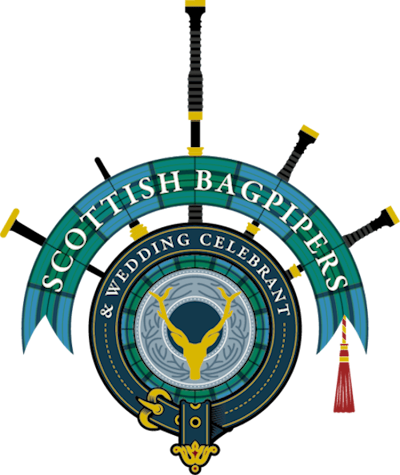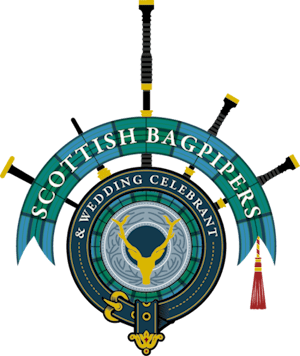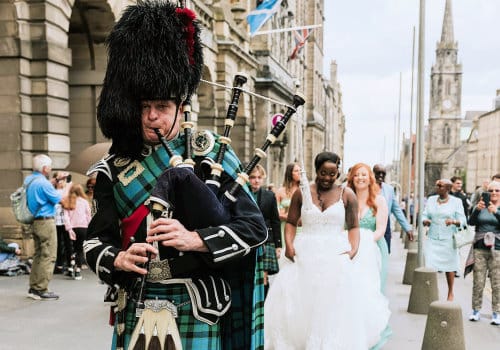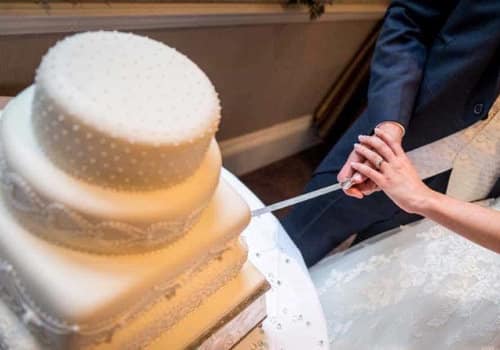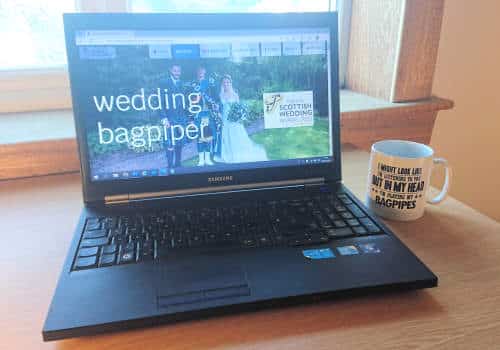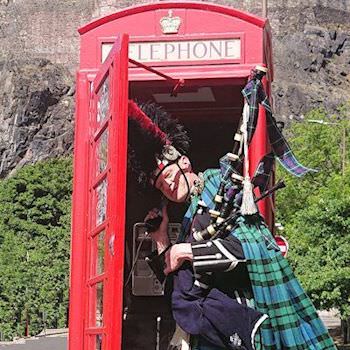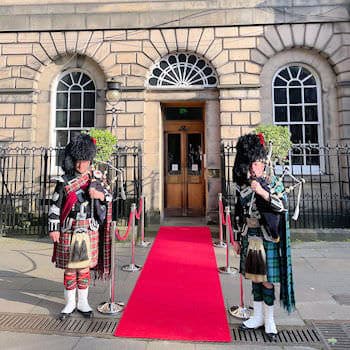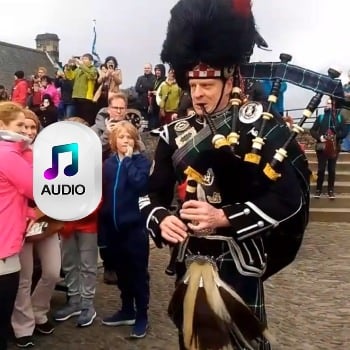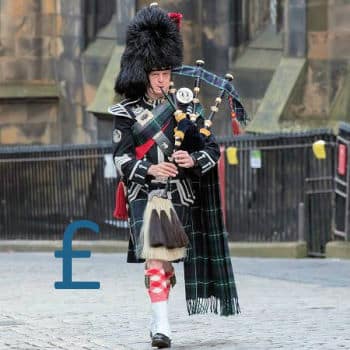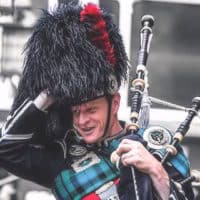The Ultimate Guide to planning your Wedding Bagpiper!
Okay, you’ve decided that you’d like a Wedding Bagpiper to play on your big day, to add those essential ceremonial and Scottish touches, and to enhance the sense of occasion…
I’m with you. You’ve made a great choice!
Perhaps you’ve seen bagpipers playing at a wedding before. But…, you may never have had a bagpiper play for YOU before, amd you want it to be right for your own wedding. So you have all sorts of questions!
I have loads of experience of piping for many, many weddings at all sorts of different venues, so let me give you a helping hand in deciding when and where your bagpiper can play at your wedding!
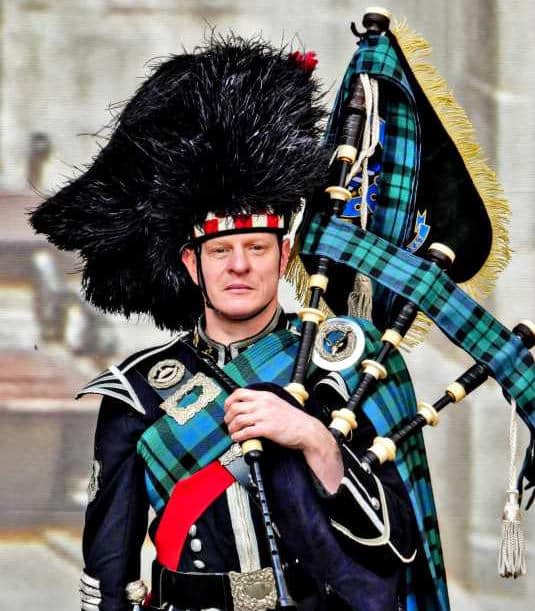
Hello and welcome!
I’m Bagpiper Glyn Morris
I’m a Weddings and Events Bagpiper based in Edinburgh, Scotland. I’ve played the bagpipes for many, many couples’ weddings, in Scotland and overseas. After nearly 30 years in the job, I thought it was time to write the ultimate guide on WHAT DOES A BAGPIPER DO AT A WEDDING!
You can see my Wedding Bagpiper Services here, but this guide is not about me. Here I’m simply going tell you how a bagpiper can compliment, and add a wonderful impact to the big moments of your special day!
When does a bagpiper play at a Wedding?
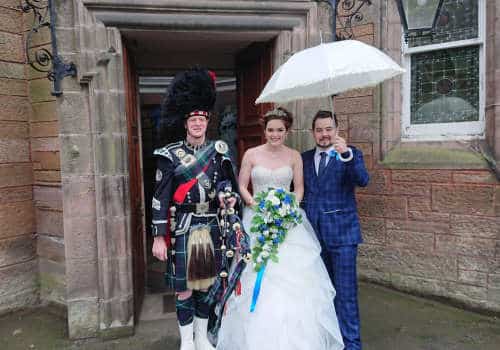
A bagpiper can play a small, or a large part in your wedding day. It’s worth remembering that one of things that bagpipes, and bagpipe music excels at, is to make an announcement, for formal occasions and for celebratory ones. This has been one of the uses of the instrument for centuries.
Your wedding day will have many symbolic, ceremonial and celebratory parts, offering many opportunities for bagpipe music to compliment these important wedding rituals and help make your “announcements”.
First things first…
Which parts of your Wedding Day that you want your bagpiper to play at, is what to decide first of all. What’s important though, is that it’s your day, and you decide!
This guide goes into the nitty-gritty of the different points in your wedding ceremony and wedding reception where bagpipes may be played.
The specific points that a bagpiper can play at are also summarised on my Wedding Bagpiper page.
How long should your bagpiper play?
Before we dive into the details of the different parts of your wedding day where a bagpiper can play, we’ll take a quick look at how long your bagpiper is likely to be in attendance at your wedding, and how long he or she actually plays for.
If you wish for your bagpiper to play at both your ceremony and wedding beakfast, your bagpiper will typically be in attendance for between three and five hours. Should you require your bagpiper for only one part of your day, then your bagpiper will be on-site for between one and two hours.
Less is more…
The different points of your day will require your bagpiper to play for different lengths of time. Your bagpiper should not play constantly though. In fact, often “less is more”. As mentioned earlier, the “big” Highland Bagpipes are great to “make an announcement”. The bagpiper should play for the key moments of your choice, to enhance the impact of that moment, but not “over do it”. Otherwise, some of the impact of the most symbolic and important parts of your wedding day, such as when you walk up, or walk back down the aisle, can be lost a little.
Wedding Ceremony
Arrival of your guests
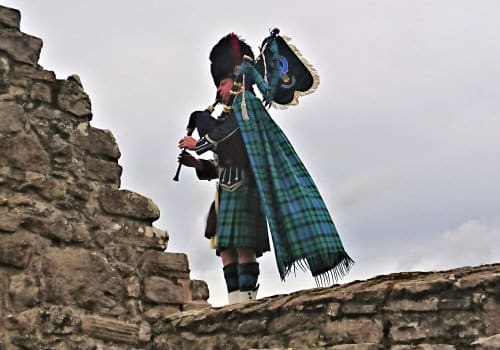
This point of your day is when your bagpiper is likely to play for the longest duration. Your guests will typically not arrive en-masse at exactly the same time (unless you’re kindly providing a coach!), so I like to be ready to play for 45 minutes before the start of your Wedding Ceremony to ensure that I can welcome the majority of your guests upon their arrival.
To welcome your guests, your bagpiper should be standing in a place that most of your guests will need to pass by, to actually get to your ceremony or reception venue. This doesn’t always need to be right at the front door though. If you’re getting married in a venue which has grounds, or a long driveway, your bagpiper can stand here to welcome your guests.
Each individual wedding venue, from the small and intimate, to the large and grand, inside or outside, will offer different suitable places for your bagpiper to “set out their stall”.
Some venues may offer a prominent position for the bagpiper to stand and play from, such as a roof or a castle turret, as seen at Craigmillar Castle. Positions like these offer great photo opportunities!
Arrival of your Bridal Party
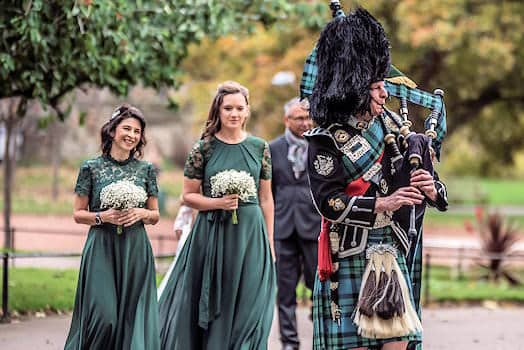
Photo by Gee @ Geebz Photography
If you and your bridal party are not already at your wedding ceremony venue, and you’re arriving in separate cars, then your bagpiper can play to welcome your bridal party to your ceremony.
The bagpiper would only play for a short time here, as your bridesmaids get out of their card and perhaps have some photographs taken. The bagpiper would not normally play the bridesmaids into the venue by themselves either. We’re now at the stage of the day where the bagpipes should be played for the bride or partner only.
The Bride’s Arrival!
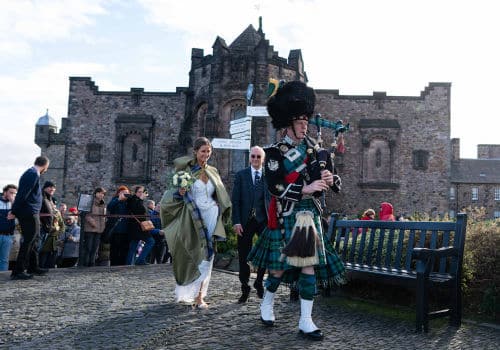
Photo by Lee @ Our Dream Photography
Now it’s time for the arrival of the bride in her car, taxi, helicopter, motorbike, horse and carriage, Shanks’ Pony (endless possibilities!), accompanied by the person who will walk her up the aisle!
Here I will typically play for just a short time. You may wish to take some time to prepare yourself and your Bridal Party to walk down the aisle, and settle any nerves – you don’t need music accompaniment during this time!
Going back to the earlier point about not having your bagpiper “over-do it” – you’re about to walk up the aisle, which is when you’ll want maximum impact, and for the bagpipes to enhance that special moment. A period of quiet before you walk up the aisle also adds to the suspense!
Up the Aisle – Part 1
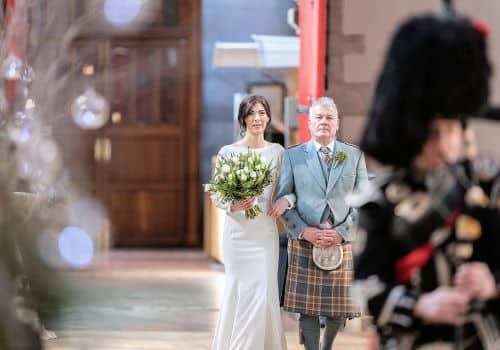
Photo by Jonathan @ Love Wedding Photos & Film
Flowers in hand, bridesmaids lined up, dress sorted, Bagpiper and photographer all set, Nerves steady (maybe!)… Right, lets’s go…
Which bagpipes should I choose for walking up the aisle?
Wait, which type of bagpipes are best?!
Walking up the aisle will be one of the really BIG moments of your day! You’ve decided that you want bagpipe music to accompany you, but which type of bagpipes would you like played here?
The big, high volume Highland Bagpipe recognised by everybody, actually isn’t the only type of bagpipe in existence! We also have the Scottish Small Pipes, which are very different. These are not only physically smaller, but have a completely different sound to the Highland Pipes. The Small Pipes are much quieter, but with a rich, mellow and harmonic sound.
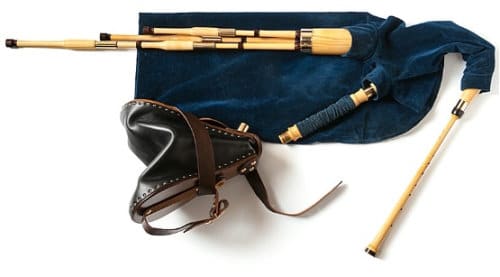
The Scottish Small Pipes
The Small Pipes are traditionally a folk music instrument. Due to the majority of bagpipers being taught in Pipe Bands, all playing the Highland Bagpipe, most bagpipers have never been exposed to them. The fact that they’re operated by bellows, and not by the bagpiper’s lungs also make them quite tricky to master. Indeed, the Small Pipes almost became extinct by the mid 20th century!
Here’s some sample audio and video of the Small Pipes in action!
Listen to the Small Pipes!
Regarding which type of bagpipe you choose to have played as you walk up the aisle, there is no right or wrong answer. Sometimes the answers to the simple questions are best though – which do you prefer the sound of?!
You may also wish to consider what sort of entrance you wish to make. The Highland Pipes have more presence due to their volume and physical size. Undoubtedly, they create more of an impact and your entrance will be more dramatic. People cannot help but stop and look! Being played up the aisle to the Highland Bagpipes is also a centuries-old tradition!
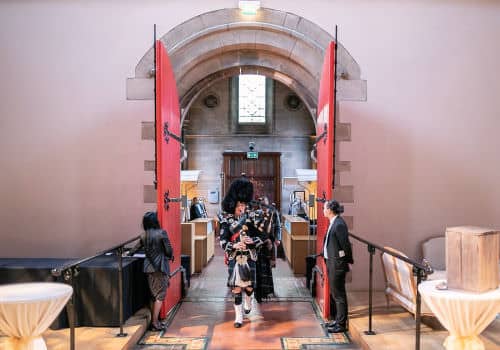
The sound of the Highland Pipes in a big venue with high ceilings, such as a church, cathedral or castle can be magnificent.
However, you may wish for your entrance to be more subtle, in which case the quieter and mellower Small Pipes are ideal. Having the Highland Pipes played at some of the earlier and later parts of your wedding celebrations, but having the Small Pipes played as you walk up the aisle also offers a nice contrast. This is another possible “less is more” scenario!
If your wedding ceremony is being in held in a smaller venue, you may feel that the quieter Small Pipes are more appropriate for the acoustics of that venue.
Up the Aisle – Part 2
Now that you’ve chosen which bagpipes you would like to have played, you’ll then need to decide if you and your bridesmaids make your entrance together and make your way up the aisle in a single procession, or if you’d like your Bridesmaids to make their entrance before you, before you then make your own entrance and procession.
Having separate processions can work very well in larger venues which have a long aisle. Here your bagpiper can play your Bridesmaids up the aisle and then stop, before going back to lead the bride up the aisle. The silence when your bagpiper stops playing for your Bridesmaids, before starting again to play for the bride is very effective and adds to the sense of anticipation of the Bride making her own entrance!
By playing a different rhythms of tunes for your bridesmaids and then for the bride, will help create a contrast between the two processions (we’ll get to what bagpipe music should be played at a Wedding later in this guide).
Where does the bagpiper go when I’m walking up the Aisle?
When piping you up the aisle, the bagpiper should lead you and your bridal party in from outside the room where your Ceremony is being held, or from a short distance away if your ceremony is outside.
The bagpiper will not play all the way down the aisle (it’s not the bagpiper’s own wedding, after all!). Upon reaching the beginning of the aisle, the bagpiper should peel off while continuing to play, and let you make your own way down the aisle. This lets your photographer get clear photographs of you during this special moment.
What’s worth considering though, is if your wedding venue has any feature which may lend itself to the bagpiper actually standing at that point, and piping from there while you make your way into the room and down the aisle. An example being the likes of the gallery shown here in the ‘New Library’ of the Royal College of Physicians.
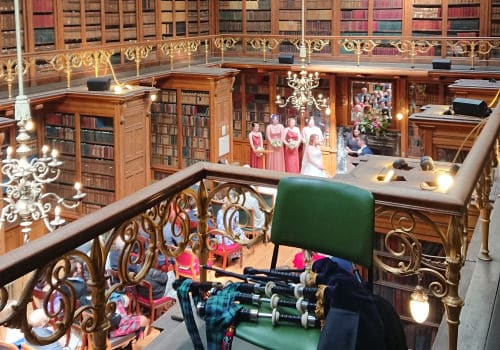
Bagpipes in the rafters at Edinburghs' Royal College of Physicians
If your Wedding Ceremony is being held outside, then you’re not restricted by space. You may be walking from another part of the grounds, or from a building in the grounds to the actual location of your Ceremony. The bagpiper can play for your approach too, and your (still patiently waiting!) partner and your guests will hear you coming!
Signing of the Register
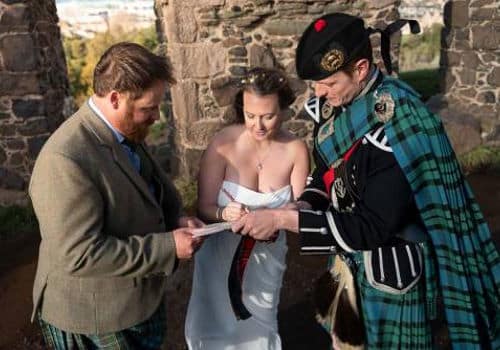
Photo by Donna @ Donna Green Photography
After you’ve exchanged your wedding rings and marriage vows, and your wedding officiant has pronounced you as a married couple(!), you’ll need to sign your Marriage Schedule. As you and your witnesses are signing this, this is an ideal time for some background music, for which the Scottish Small Pipes are perfect. The bagpiper can play a small medley of both slow and fast tunes during this period.
If the room where your ceremony is being conducted is large, the bagpiper can stand at the front and to the side of the table where you’ll be sitting at (the bagpiper is not here to interfere though). Or if in a smaller room, the bagpiper can stand closer to the door near the beginning of the aisle.
If your ceremony is outdoors, the Small Pipes will work perfectly well here too.
Back down the Aisle
Congratulations, you’ve sealed the deal!
This is the time for some celebratory tunes on the Highland Pipes. If you choose to have bagpipes played here, your bagpiper should start playing immediately after your wedding officiant “presents” you both to walk down the aisle as a newly married couple. Your bagpiper will start playing and wait as you make your way down the aisle, before turning and leading you both out of the room that your ceremony has been held in, or to a different area of the venue for you to begin your celebrations and have some photographs taken.
Your bagpiper should step away a little to not get in the way of your guests wishing to congratulate you!
Confetti Shower
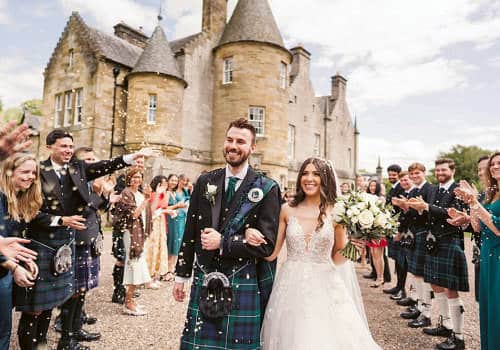
Your Confetti Shower will take place shortly after you’ve walked down the aisle as a married couple. Your bagpiper can play here to add a sense of to the ceremony, by leading you from a short a distance away, from inside the venue to outside and through the line-up of your guests, for example.
Your bagpiper will play some lively and celebratory tunes here while photographs are being taken. This another occasion where the bagpipes are “making an announcement”. In this case providing a clear signal to your guests that you’re both on your way, so get prepared to throw the confetti!
Wedding Reception
Arrival at your Reception
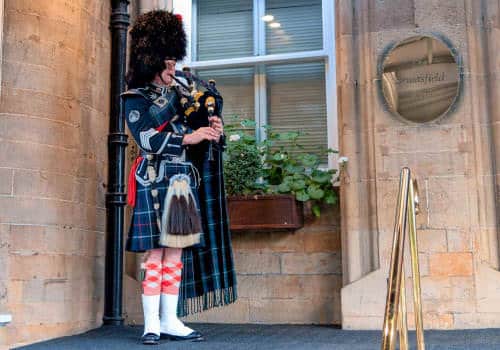
If your wedding reception is being held at a different venue to your ceremony, your bagpiper can play outside to welcome you and your guests to your Reception venue.
Your bagpiper will treat this part of your day in the same manner as when playing for your guests’ arrival at your wedding ceremony, and should position him/herself in a suitable place where you and your guests will pass by, but stand back a little.
Drinks Reception
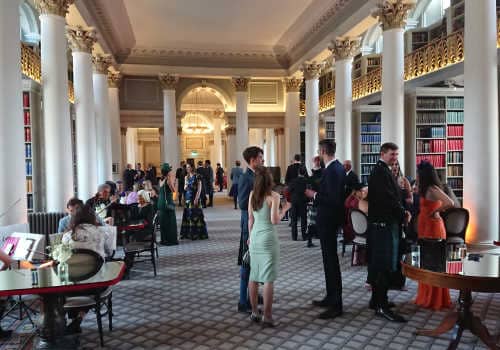
If you would like some music during your drinks reception, then the Scottish Small Pipes are highly recommended here. The volume of the Small Pipes is perfect as background music. Your bagpiper can also play the Small Pipes with a fiddler/violinist, guitarist and percussionist, in the same way that a string quartet performs during this part of a wedding.
Call to Dinner
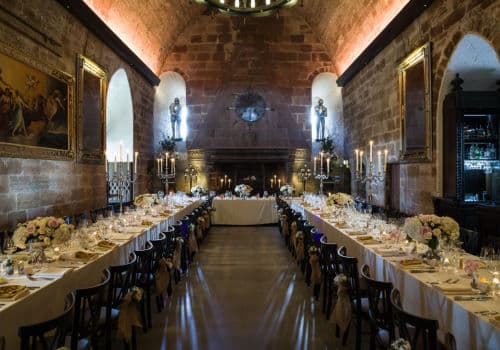
Your reception venue will typically call your guests to take their seats at the wedding breakfast up to 15 minutes before it’s time for you and your partner to go in.
Your bagpiper can play here as your guests make their way into the dining hall. This is another example of where the bagpipes serve to “make an “announcement”. In this case it’s “Your dinner is about to be served, and your bride and groom will shortly be making a grand entrance!” Having bagpipes played here prompts your guests (who maybe otherwise engaged at the bar!) to make their way to their seats. It’s also important that this part of your day runs to schedule, due to the fact that chefs will be preparing your food to arrive at a particular time.
Instead of the Maître d’ making the announcement to instruct your guests to take their seats in the dining hall, your bagpiper who will be a commanding figure wearing the ceremonial Piper’s Full Highland Dress, can do this instead.
Either the Highland Bagpipes or the Scottish Small Pipes may be played here.
Married Couple to the Top Table
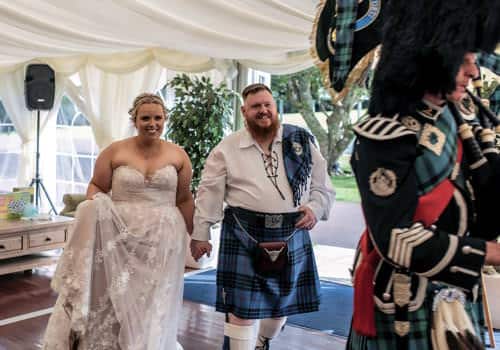
Your guests are all seated and waiting. Now it’s some for you both to make a grand entrance as a married couple, to your Wedding Breakfast!
Here your bagpiper will lead you both, starting from outside the dining hall, through the dining hall and up to the top table for you to take your seats. This is an important ceremonial part of your day, and announces the start of your wedding breakfast. The Highland Pipes are a ‘Must’ here. They compliment your grand entrance and the extra volume is needed, given that your guests will be clapping and cheering!
Your bagpiper may also perform the Master of Ceremonies role here, to officially announce your entrance prior to piping you both to the Top Table.
The Piper’s Toast
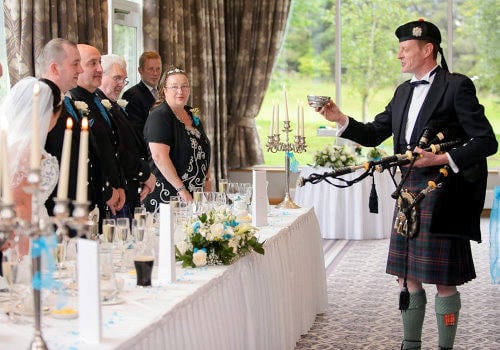
At scottish weddings, it’s a tradition for the bride to present the bagpiper with a ‘dram’ of whisky. Presenting the dram, not only signifies the end of the bagpiper’s duties for the day, but also enables the bagpiper to recite the time-honoured Piper’s Toast to the Bride and Groom.
Once you’ve both taken your seats at the top table, your bagpiper will take over for a short while, and will address you and your husband/wife, and also your guests. At which point, both the the traditions of the bride presenting the dram, and the Piper’s Toast will be explained, and you’ll know it’s then time to pass the dram to your bagpiper.
Different bagpipers will do this differently, from a simple Slàinte Mhath (Good health), to the more elaborate and ceremonial. A “proper” Piper’s Toast should be more ceremonial, and it’s also good fun! There’s a poem composed by the 17th century Scottish poet and playwright, Alan Ramsay, which I recite here. I also like to recite a short toast to your guests and family, so everybody in your Wedding party is involved.
End of your bagpiper’s duties
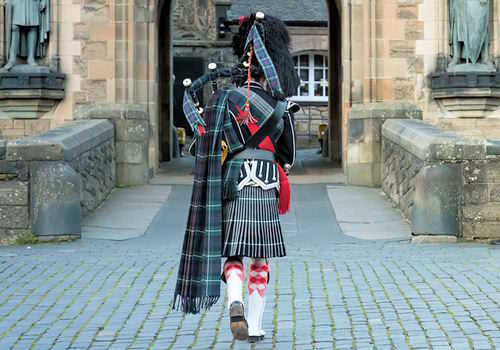
Upon finishing the Piper’s Toast, the bagpiper will kiss the underside of the glass or quaich (to signify that the whisky has been finished!), strike up the bagpipes again and pipe back out of the dining hall. This lends a natural conclusion to the bagpiper’s duties, and lets you nicely progress on to your speeches, should you be having these before your wedding breakfast is served.
This will mark the end of your bagpiper’s ceremonial duties on your day. However, your bagpiper can play a part in your evening entertainment, which we’ll look at below.
Evening Entertainment
Welcome your Evening Guests
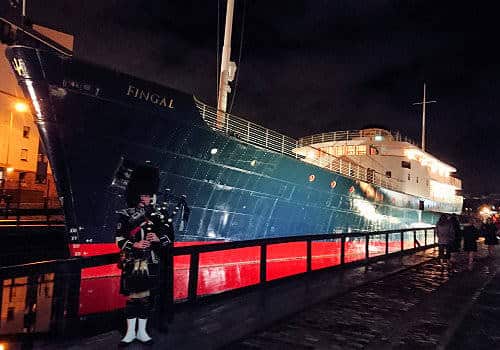
If you don’t want your evening guests to miss all the fun, then your bagpiper can play outside your reception venue to welcome them upon their arrival.
You may wish to consider if you also have anything else happening around this time of your day, which would be appropriate for your bagpiper to play at. For example, if you and your entire wedding party will make your way from one part of your venue to another part, such as a marquee or hall where the evening’s entertainment will take place. Another example would be if you were to cut your wedding cake at some point in the early evening.
Highland Dancing Display
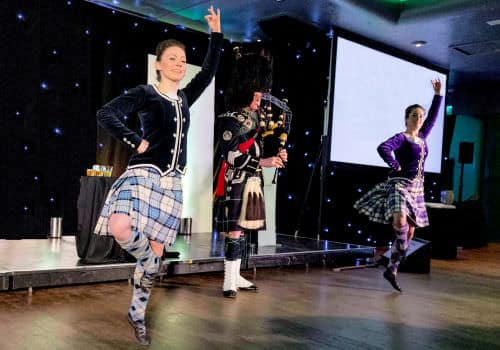
A Highland Dancing display accompanied by your bagpiper provides a great spectacle during the evening entertainment at a wedding, and will really wow your guests! Highland Dancers can perform the famous “Sword Dance” which features intricate steps around two Scottish Broadswords.
Arranging a Highland Dancing display as a surpise for your guests will make it all the more memorable. Your bagpiper will march into your Reception room piping, and leading the dancers to a spot on the dance floor. After introducing the dancers and the dances to be performed, then the dancing will begin.
A Highland Dancing display should last around 15 to 20 minutes, just the right amount of time for your guests (and your wedding band or DJ) to take a rest and recharge before the rest of your evening’s entertainment.
Pipe Band to Beat the Retreat
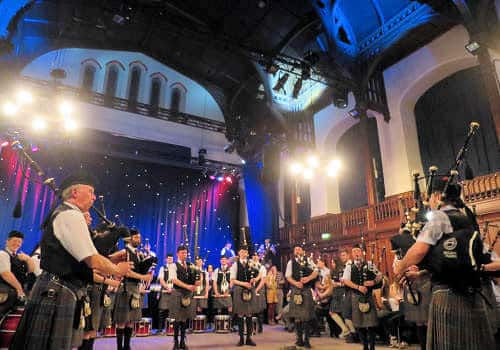
Stockbridge Pipe Band, Edinburgh
If you want to “go big”, then nothing makes a bigger impact than a full Pipe Band making an entrance and performing the “Beating the Retreat”. This has military origins, historically serving as an order for soldiers to return to their camp or barracks at the end of the day. At a wedding, a Pipe Band Beating the Retreat can be used to bring a climatic and definitive Scottish conclusion to the end of your Wedding Reception, and will see your wedding guests off in fine style!
The Pipe Band will march into your venue in formation, before forming up in ranks or in a circle, and playing some more selections of tunes. At the end of the performance, the Pipe Major should formally salute the couple and ask the bride’s permission for the band to retire. The band will then march back out. At larger venues, the Pipe Band can play outside close to the entrance.
A pipe band can be tailored to your requirements and budget. A Mini Pipe Band comprising fewer pipers and drummer than a full size band is also a fine option.
A Pipe Band can can also play at an earlier point in the evening, such as after your buffet or when your wedding band or DJ is taking a break.
What music should your bagpiper play?
Bagpipe tunes for different parts of your Wedding
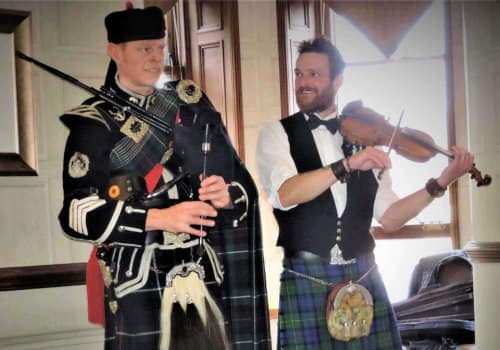
The different parts of your wedding day will naturally lend themselves to a different “mood” of bagpipe music being played for each. Note: we call a piece of bagpipe music a “tune”!
Your bagpiper should be aware of these different moments and play tunes which compliment the mood of each moment. I describe the “mood” of each part of your day when a bagpiper can play, as follows:
Guests Arrival – “Welcoming”
Bridal Party & Bride’s Arrival – “Welcoming, but more formal”
Bride’s procession uf the Aisle – “Slow & Stately”
Signing of the Register – “Cheery & Easy Listening”
Back down the Aisle – “Celebratory”
You may be happy to leave the choice of bagpipe music to be played to your bagpiper’s discretion. A bagpiper who’s on top of their game should know what’s appropriate to be played at what time. If you would like hear some options, as many people do, your bagpiper should be able to provide recordings of a number of a bagpipe tunes which are appropriate for each part of your day. Head over to my Wedding Bagpipe Music to hear my own recordings of bagpipe tunes appropriate for different parts of your wedding day.
If you have a request for a piece of bagpipe music that you particularly like, but you don’t know if your bagpiper can play it or not, be sure to ask. Bear in mind that bagpipers must commit a tune to memory – we don’t have the luxury of being able sit in front of a music stand like a member of a String Quartet! Therefore, you should make any such request in plenty of time so your bagpiper can learn it if necessary.
Can modern songs be played on the Bagpipes?
Modern songs on the bagpipes
If you would like a piece of music played which isn’t originally a bagpipe tune, perhaps the melody to a pop/rock song or another contemporary piece of music, you must ask your bagpiper if it’s possible to be played on the bagpipes, and importantly, “does it work on the bagpipes?”
The bagpipe only has nine notes. Many pop/rock and contemporary songs go higher and/or lower than the limits of the bagpipe scale. You may have heard bands such as the Red Hot Chilli Pipers performing all manner of well known songs. However, the bagpipes in this type of band are being accompanied by numerous other instruments, such as guitars, bass and drums. These other instruments provide the necessary ensemble to fill in the gaps in some songs which don’t fit on the bagpipe scale, or have very long notes which don’t sound natural when played by a solo bagpiper.
Your bagpiper should be able to advise if the song you request is appropriate to be played by a solo bagpiper.
What should your bagpiper wear?
Your Bagpiper’s Uniform
Bagpiper’s No.1 Full Highland Dress
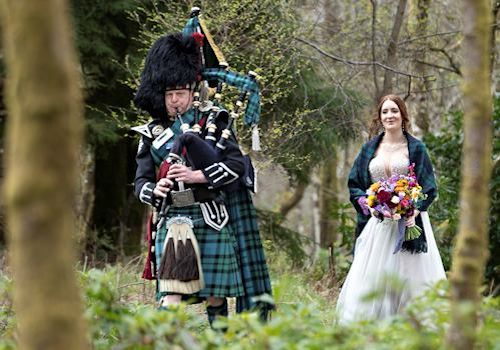
There are two styles of uniform, or “dress”, typically worn by bagpipers. If you think of the more iconic images you have of a bagpiper, you will think of a uniform just like that worn by bagpipers perfoming in the Edinburgh Military Tattoo. This uniform, consisting of the big hat, big horse hair sporran, big long plaid and fancy belts, is known as the Piper’s No.1 Full Highland Dress, or simply “No.1s” as we say. This is the most spectacular bagpiper’s uniform, and is traditionally worn when performing at formal and ceremonial occasions such as weddings.
Your bagpiper dressed in “No.1s”, without doubt adds a definite sense of ceremony and formality to your wedding day, and looks fantastic in photographs. You can find out what makes the Piper’s No.1 Full Highland Dress so special, by taking my Bagpiper’s Uniform Tour here!
However, not all bagpipers wear this uniform due to it being very expensive, less comfortable to wear for long periods, and needing some skill to wear it properly. I wear the No.1 Fill Highland Dress as standard, and I don’t charge a premium. Many bagpipers though (not all), either don’t offer it, or will charge more. If you want your bagpiper to wear this dress, be sure to check that it is offered, and whether or not it is offered as standard.
Also check that your bagpiper actually wears the No.1 Highland Dress in its entirety. Some bagpipers out there may choose not to wear the long plaid, or the big hat (Feather Bonnet). Wearing the No.1 Full Highland Dress without the Feather Bonnet is akin to wearing a Saville Row suit with a pair of trainers. #mightaswellnotbother
Bagpiper’s Day Dress
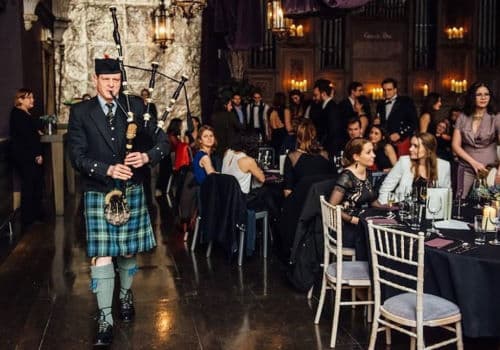
Day Dress is what the vast majority of bagpipers wear nowadays. This form of Highland Dress is very similar to the men’s standard kilt outfit, but with the addition of the Glengarry Hat.
Whilst Day Dress is undoubtedly less spectacular and less ceremonious than the No.1 Full Highland Dress, you may like your bagpiper to wear Day Dress should you wish your wedding to be less formal. I.e., you may feel that your bagpiper dressed up to the nines in No.1 Full Highland Dress, may be a bit out of place if you would prefer less formality.
Also, in recent years, many new styles of tweed jackets and waistcoats, and kilt hose (socks) have been produced by highland outfitters. It used to be very much a case of “you can have any colour of jacket you want, so long as it’s black or green”! This is not the case now though, and with the many different styles and colours of tweed now available, a bagpiper wearing Day Dress can still look pretty dapper, and can stand out from other kilted members of your wedding party. I recommend you look at the photos of various bagpipers to see how they’re turned out.
You may also wish to consider your wedding photographs. If your wedding is being held outdoors in a beauty spot, you way wish your bagpiper to “dress down” a little in order that there is more focus upon the scenery of your photos, rather than upon your bagpiper.
